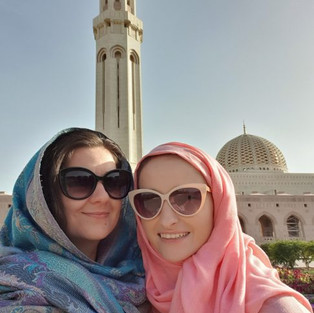The Weekender | Muscat Edition
- Marina Milic

- Apr 11, 2019
- 7 min read
Updated: Jul 20, 2022

When I think of Oman, flashing images of beautiful wadis, perfectly textured mountains, and a haven for hikers and nature seekers come to my mind. Muscat, the capital city, always seemed to have been slightly left behind in those glossy travel brochures, and so with a free weekend in March, my friend and I decided to take a spontaneous trip and see what the city has to offer. Oman is one of the oldest countries in the world, witnessing history over the last 100,000 years through native tribes and foreign settlers like the Persians, Portuguese, Ottomans, Indians, East Africans and many more, awakened my natural curiosity to learn more about the colourful destination.
3 in 1 cities
Wedged between the beautiful ocean and rocky Hajar mountains, Muscat at first seems like a sleepy city spread across a huge landmass, however little by little, the ancient city slowly reveals its worldly charm. Locally, the city is divided into 3 main suburbs each offering a unique element contributing to the overall character of the city.
Often described as 3 cities within 1, here is a closer look at the main suburbs of Muscat:
Ruwi – locally known as Little India, this part of the city is well known for its shopping centres, mosques, and bustling market atmosphere. It is one of the oldest parts of Muscat and is characterised by narrow alleys and lively streets.
Mutrah – the focal point of any city is usually the coastline as it was a place for fishermen and traders to exchange goods from around the world. Muscat’s historical port and souq are located in the Mutrah suburb, which is the place “to see and be seen”. This part of the city is filled with traditional restaurants and antique museums as well as the popular fish market, making it a great place to witness everyday Omani life.
Old Muscat – one of my favourite parts of the city is the historical neighbourhood and epitome of Arabian charm. This part of Muscat is surrounded by historical forts built on top of the Hajar mountains, palaces, art galleries, and the Bay of Muscat’s promenade.
Other suburbs such as Madinat Al Sultan Qaboos, Al Qurum, and Al Khuwair each offer their own unique attractions and varied offerings.

Things to do
The diversity of Muscat makes it appealing to almost every type of traveller, whether you are interested more in historical sights, bustling markets, exotic food, or natural landmarks (such as a day trip to Nizwa and Sur). A note to the wise, if you are travelling to Muscat over the weekend, take into consideration that majority of the sights are closed until 4pm. I would recommend that when building your itinerary make sure you plan it according to the opening hours. It is common practice to take a lunch break every day between 2pm – 4pm so most shops and museums are closed.
Here is my hit list of the top places to visit in Muscat:
BAIT AL ZUBAIR
If there is one place you simply cannot miss in Muscat, it is Bait Al Zubair (House of Zubhair). This private museum is owned by the prominent Al Zubair family and has been turned into a historical haven showcasing beautiful artefacts and pieces of art passed down from generations, while the detailed exhibits perfectly express the vibrant history and culture of Oman.
Opening hours: Sat – Thurs, 9:30am – 12pm & 4pm – 7pm (closed on Fridays) Entrance fee: OMR 1
ROYAL OPERA HOUSE Music lovers will be in for a treat when visiting the Royal Opera House, which has been on my list for a long time. Although housed in a contemporary structure, this stunning venue showcases the best of classical music through a variety of cultural programs and a dynamic repertoire. Did you know that the Royal Opera House was inaugurated with the opera Turandot conducted by Placido Domingo, one of the world’s greatest tenors?
During our visit, we were very unlucky as there was no performance, however we did visit the 400 Years of Opera exhibition organised by the Victoria and Albert Foundation which delightfully showcased the history of opera from its Venetian beginnings in the 1700’s, until it came to life in Oman in 2011.
Opening hours: 8:30am – 5:30pm (performance dependent)
MUTRAH SOUQ
No matter which country I go to around the world, I always make it a point to visit a Souq, Bazaar, or famous marketplace – it is after all the meeting point of the local community. The Mutrah Souq is one of the most chaotic markets I have ever been to, characterised by a maze of narrow alleyways and dark lighting. It is filled with shops selling everything from frankincense and spices, to traditional costumes, lamps, toys, jewellery, and cookware. A constant flow of people coming and going, negotiating on pricing, and testing products is guaranteed, including a combination of aromas and sensations from all the spices – which may be slightly overwhelming at first.
MUTRAH CORNICHE
A waterfront promenade which spans 3 km teemed with traditional cafes, the hustle and bustle of Mutrah Souq, fountains, gardens, and serene views of docked ships and dhows. This beautiful walkway located along the coastline is a great place to stroll along the city and enjoy all the sights, sounds, smells, and tastes of the city. My friend and I caught a bird’s eye view of the Corniche area which creates a perfect postcard, blending the city with the mountain range and sea.



AL ALAM PALACE
Al Alam Palace is a 200 year old establishment located between the famous Mirani and Jalali Forts, which were built by the Portuguese in the 16th century. Although the palace does not allow visitors to its inner grounds, the exterior is a great place to take some pictures while admiring the gold and blue façade of the humble palace.

SULTAN QABOOS GRAND MOSQUE
Just like in Abu Dhabi, Muscat’s Sultan Qaboos Grand Mosque is a must visit. It holds special value to the Omanis as Sultan Qaboos gifted it to the nation on their 40th National Day. The impressive structure holds over 600,000 Swarovski crystals, 24 carat gold plating, is embellished with beautiful mosaics, and used to have the world’s largest carpet. Non-Muslims are allowed to visit the Mosque, however please remember to dress conservatively (and ladies, cover your hair).
Opening hours: Saturday – Thursday, 8am – 11am (non-Muslims)

DOLPHIN TOUR
One of the biggest highlights of the visit was the possibility to see dolphins in their natural habitat. We booked a Dolphin Tour with Coral Ocean Tours and enjoyed a 2 hour long cruise across rocky waters. The tour guide did warn us that there would be a 70% chance of spotting dolphins and when I realised just how many boats go out to the same location I lost hope. However, we did spot them, and they were beautiful! The remainder of our cruise was along the coast of Muscat where we admired beautiful rock formations while enjoying the perfect weather. Tour price: OMR 15 Tour company: I booked this tour with Coral Ocean Tours – just ask for Sathish, he will take care of the rest!



Places to Eat
Omani food is a constellation of flavour which pay tribute to the country’s expansive history blending in the East with the West. Visitors can enjoy dishes infused with exotic Asian spices and strong Arabian essences like frankincense, prepared with a combination of cooking methods. The city offers a range of options suited for every preference, as most restaurants offer both traditional and international options.
Here are some suggestions for places to enjoy traditional and international cuisine when visiting Muscat:
Kargeen Café Located in Madinat Al Sultan Qaboos Complex, Kargeen Cafe is a sanctuary, hidden away from the main street and concealed in a compound surrounded by lush gardens. The moment you enter its premises, you will feel transported to an ancient garden characterised by wooden furniture, graceful fountains, and traditional decoration seen in museums. A local baker making sensational roti bread in a traditional tandoor clay oven welcomes you with a smile, while large comfy couches set the stage for a relaxing experience. We visited during the day time, however at night this sanctuary comes to live with hanging fairy lights, bursts of colour, and laughter. The menu is balanced offering traditional Omani, Arabic and International dishes.
Bait Al Luban Bait Al Luban is the poshest restaurant in Muscat and translates to “House of Frankincense”. Visitors are in fact welcomed to the table with a glass of cold water infused with the essence – initially strong for those who are not used to it but has a pleasant after taste.The setting is very traditional and has the best view in the entire city – towering above Old Muscat’s coastline.
Trader Vic’s This was my 3rd Trader Vic’s, and it is always an eclectic place to enjoy yummy cocktails (like the Chi Chi or Tiki Puka Puka) and bites while enjoying vibrant Latin music. It is located at the InterContinental Muscat however be warned, the DJ does not start before 9pm.
The Essentials
Transportation Taxi costs are very high compared to the UAE and I would strongly recommend that visitors rent a car (if they can). Taxis are not metered so bargaining is necessary, just don’t be surprised if you are ripped off. A friend also recommended to download the Otaxi App which is similar to an Uber however you need mobile data for this, or Wi-Fi which is not always available.
Getting there Muscat is located just 1 hour by flight from the UAE so conveniently my friend and I flew directly. There are multiple options with Etihad Airways, Oman Air, or Fly Dubai, however adventure seekers can also get there by car or motorbike.
Visa It is always recommended to check whether you require a visa before planning your trip. Visitors who arrive to Oman by car can attain a visa on the border, whereas flying into the country may mean you need a pre-approval. UAE residents can apply for the GCC e-visa which costs OMR 5. The online portal is very easy to use and took only 30 minutes to get approval (please note, it took my companion 3 days so apply in advance). When arriving to the immigration counter at the airport, they will ask for the printed pre-approval. We were not asked to present travel insurance, return flight, a hotel booking or proof of funds, however it is always good to be prepared.
Accommodation The city is filled with hotels catering to every preference, location, and budget. For those on a relaxing weekend getaway take a look at The Chedi, Shangri-La, or Al Bustan Palace which overlook the sea. Budget travellers can enjoy safe, clean, and comfortable accommodation in hotels like Golden Tulip, Tulip Inn, and Ibis Muscat.
Did you know: In ancient times, Frankincense was very valuable due to its healing nature. The Dhofar region of Oman located along the Gulf of Oman and Arabian Sea is the most famous area for frankincense production and was part of a popular trade route. It is a very important element of daily Omani life and is used in the household daily. Here is an interesting video about the importance of Oman’s Frankincense

xo,
Marina
* OMR 1 = AED 9.57 (at the time of publishing this post)
Disclaimer: All views are my own and all photographs are © My Sweet Escapes, unless otherwise stated. Trader Vic’s images courtesy official Facebook page.





































































Kommentare